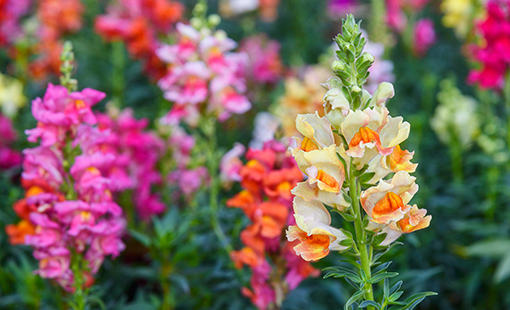
Growing Snapdragons
Snapdragons are very popular short-lived garden perennials that are usually grown as annuals. They are a mainstay of classic flower gardens, with infinite uses, from mixed border gardens to flower boxes to patio containers. The common name derives from the shape of the individual flower heads, which resemble the snout of a dragon, and which even open and close in a snapping motion, as often happens when pollinators open the jaws to reach the pollen.
Bright snapdragon flowers bloom profusely throughout cool weather in intensely saturated colors (almost every hue) and are real standouts in either the spring or fall garden. The flowers start blooming at the bottom of the stalk and work their way up, making for a long period of bloom. Although snapdragons tend to slow down and stop blooming in the heat of mid-summer, if you keep them watered, they will perk up and carry your garden through the fall.
Snapdragon Care
Snapdragons do best in rich, well-draining soil in a sunny location, though they will tolerate part shade. Pinching off the stem tips on young plants will make them thicker and bushier, and deadheading the spent flowers will extend the bloom season, often right into the first frost of the late fall or early winter. Snapdragons can repeat bloom throughout the season but they do best in the cool of spring and fall. In cooler climates, they bloom all summer long, and in milder climates, they sometimes bloom throughout the winter.
These short-lived perennials are usually grown as annuals. Even when they do overwinter, snapdragons never seem to bloom as robustly as they did in their first year. However, they should form seed pods in the first year; if you are lucky, they may even self-sow in the garden.
Light
Your snapdragons will bloom most profusely in full sun to partial shade. Once the temperature heats up, they may stop blooming altogether. Planting them in part shade and keeping them well watered will help them make it through the summer and they will likely bloom again in fall.
Soil
Snapdragons like a neutral soil pH between 6.2 and 7.0, rich in nutrients and well-draining. As short-lived plants, they are not heavy feeders, but adding organic matter will help keep them healthy and blooming.
Water
Snapdragons need adequate watering. Keep seedlings moist for the first few weeks. Once established, snapdragon will need approximately 1 inch of water per week in times of no rainfall. Water near the crown of the plant and avoid overhead watering to keep your snapdragon healthy. Once established, let the top inch of soil dry fully before watering.
Temperature & Humidity
Snapdragons are tender perennials that are hardy in USDA zones 7 to 11. But snapdragons prefer cooler temperatures and are at their best when nighttime temperatures are in the low 40s and daytime temperatures in the low 70s Fahrenheit. For this reason, they are usually grown as annuals to provide garden color in the cooler months of spring and fall.
Once established in the bed and hardened off, snapdragons can withstand sub-freezing temperatures. If you make sure they stay well-watered during cold spells and add a layer of pine straw mulch, they can last for quite some time and will survive quite low temperatures until the chill has passed.
Seedlings grown indoors need to be hardened off for about 10 days to two weeks before planting in the garden.
Fertilizer
Apply fertilizer when the plants first start producing flowers. Use a standard, well-balanced all-purpose fertilizer, such as a 10-10-10 product, at a rate of three pounds for every 100 square feet of the flowerbed. Water well to minimize the risk of nitrogen burns and to help the fertilizer reach the roots.
Common Pests & Diseases
Rust fungus can be a significant problem with snapdragons. If rust does appear in a planting, it is best to grow snapdragons in another part of the garden the following year. This plant is also susceptible to mold, fungal leaf spots, downy mildew, wilt and root rots.
Aphids and spider mites are the most common pest problem, which may require the use of pesticides or horticultural oils in severe infestations.
Tall varieties may need support to avoid toppling over, especially in shady sites where they can grow to be particularly leggy.
Information courtesy of TheSpruce.com

 Adams Fairacre Farms
Adams Fairacre Farms